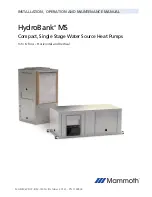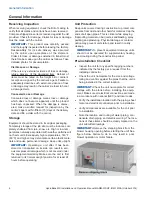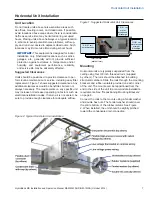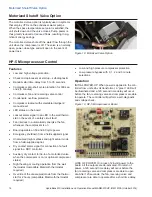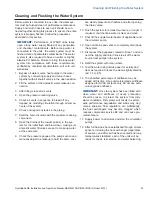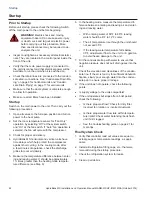
HydroBank MS Installation and Operation Manual MAMM-WSHP-IOM-1MSA (October 2014)
13
Ventilation Air Considerations
Ventilation Air Considerations
Outside air may be required for ventilation. Refer to
local codes. The temperature of the ventilation air must
be controlled so that the mixture of outside air and
return air entering the unit is within application limits. It
is recommended that the ventilation air inlet be closed
during unoccupied periods (i.e. night setback).
The ventilation air system is typically a separate build-
ing subsystem with its own distribution ductwork. Simple
introduction of the outside air into each return air ple-
num chamber is recommended, reasonably close to the
unit air inlet. Do not duct outside air directly to the unit
inlet. Provide sufficient distance for the thorough mixing
of outside and return air.
Electrical Connections
All field installed wiring must comply with all local and
national electrical codes. See “Electrical Data” starting
on page 34 for applicable fuse or breaker sizes. Con-
sult the wiring diagram provided with your unit for the
field connections required.
WARNING!
Electric shock and moving
equipment hazard. Can cause severe injury
or death. Lock and tag out all electric power
during installation.
Wiring to the unit is routed through the electrical knock-
outs in the front corner of the unit. See Figure 12 and
Figure 13
. For detailed information on knockout loca-
tions and sizes, see the dimensional drawings provided
with your unit submittal package.
Figure 12: Horizontal Unit Electrical Connections
Field control
wiring
Power wiring
Figure 13: Vertical Unit Electrical Connections
Power
wiring
Field control
wiring
On units equpped with the non-fused disconnect option,
power wiring is brought in the through the knockout in
the top of the junction box. See Figure 14.
Figure 14: Non-Fused Disconnect Electrical Connections
Horizontal Unit
Field control
wiring
Power wiring
Vertical Unit
Field control
wiring
Power wiring
Operating Voltage
Incoming power supply must comply with the data in
Table 3. Unit operation outside of the minimum or maxi-
mum range is not recommended and will result in pre-
mature component failure.
IMPORTANT!
Units operating with over- or under-
voltage conditions for extended periods of time will
experience premature component failure. Three-
phase system imbalance should not exceed 2%.
Table 3: Operating voltages
Minimum
Maximum
208-230/60/3
197 volts
253 volts
460/60/3
414 volts
506 volts
380-415/50/3
342 volts
418 volts
575/60/3
515 volts
632 volts

